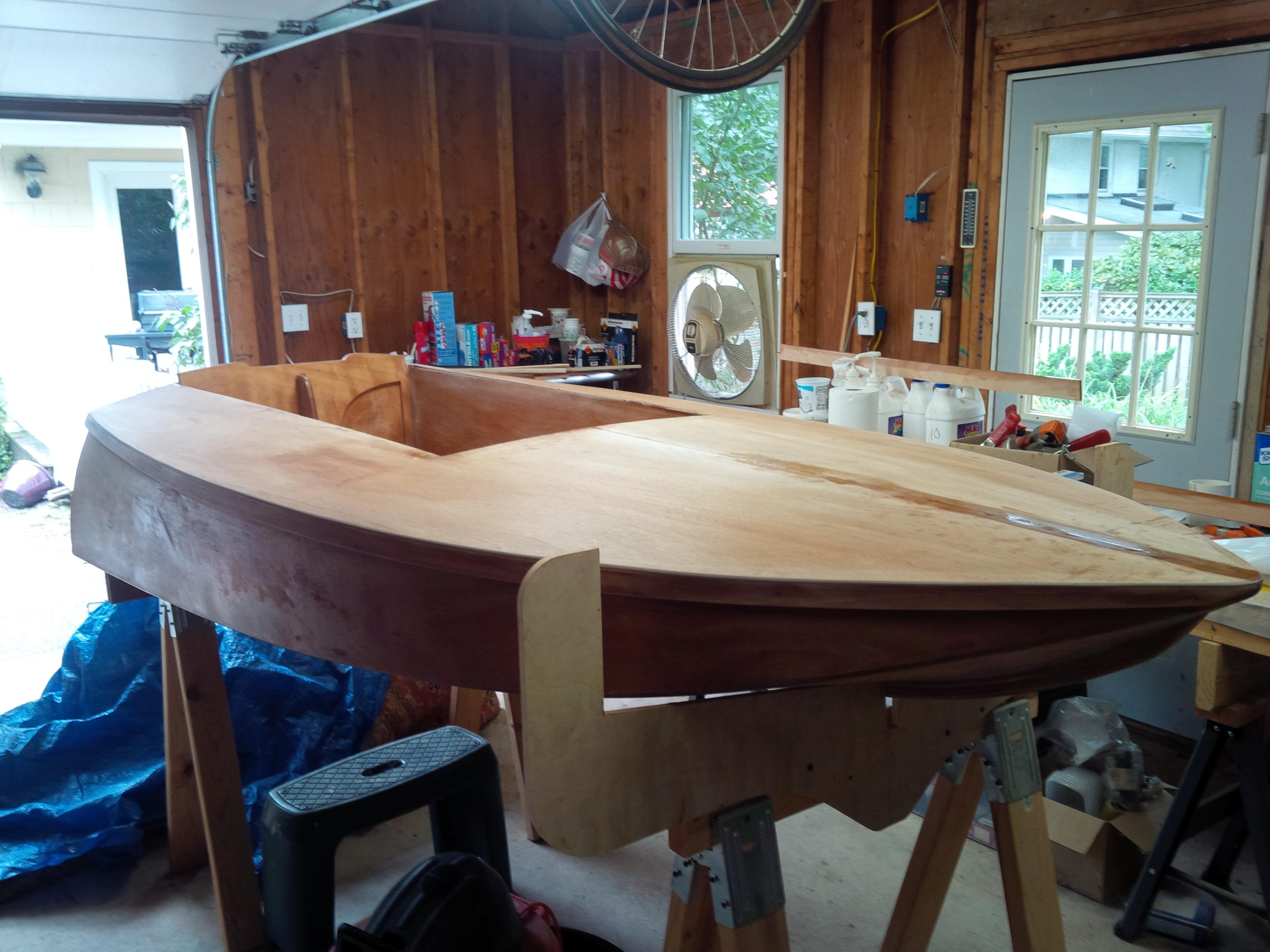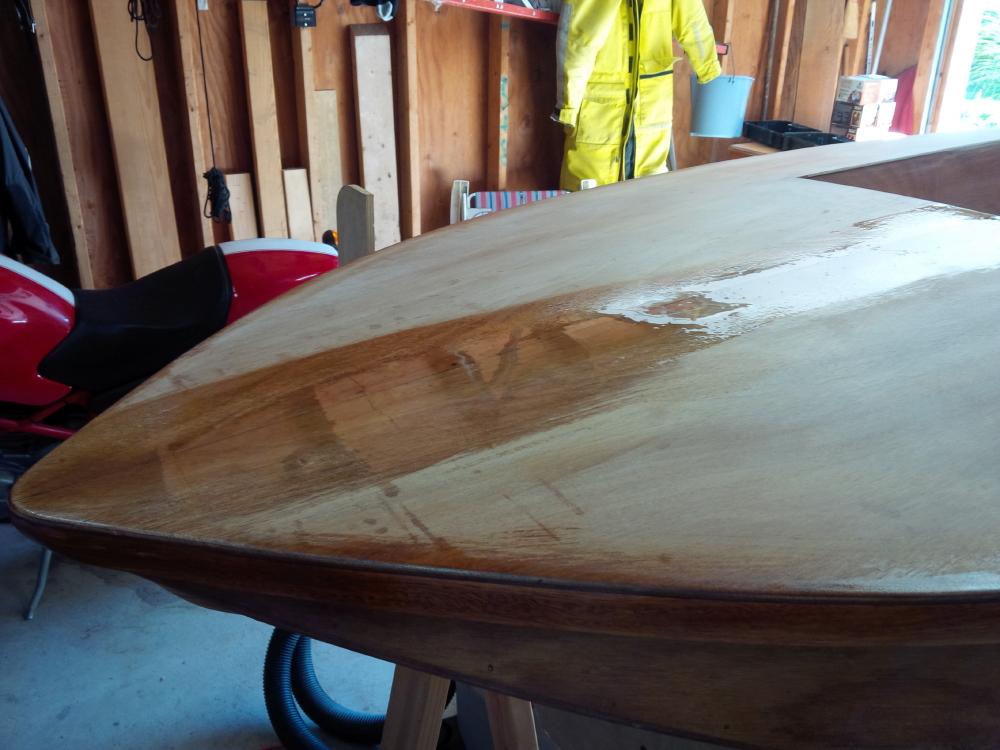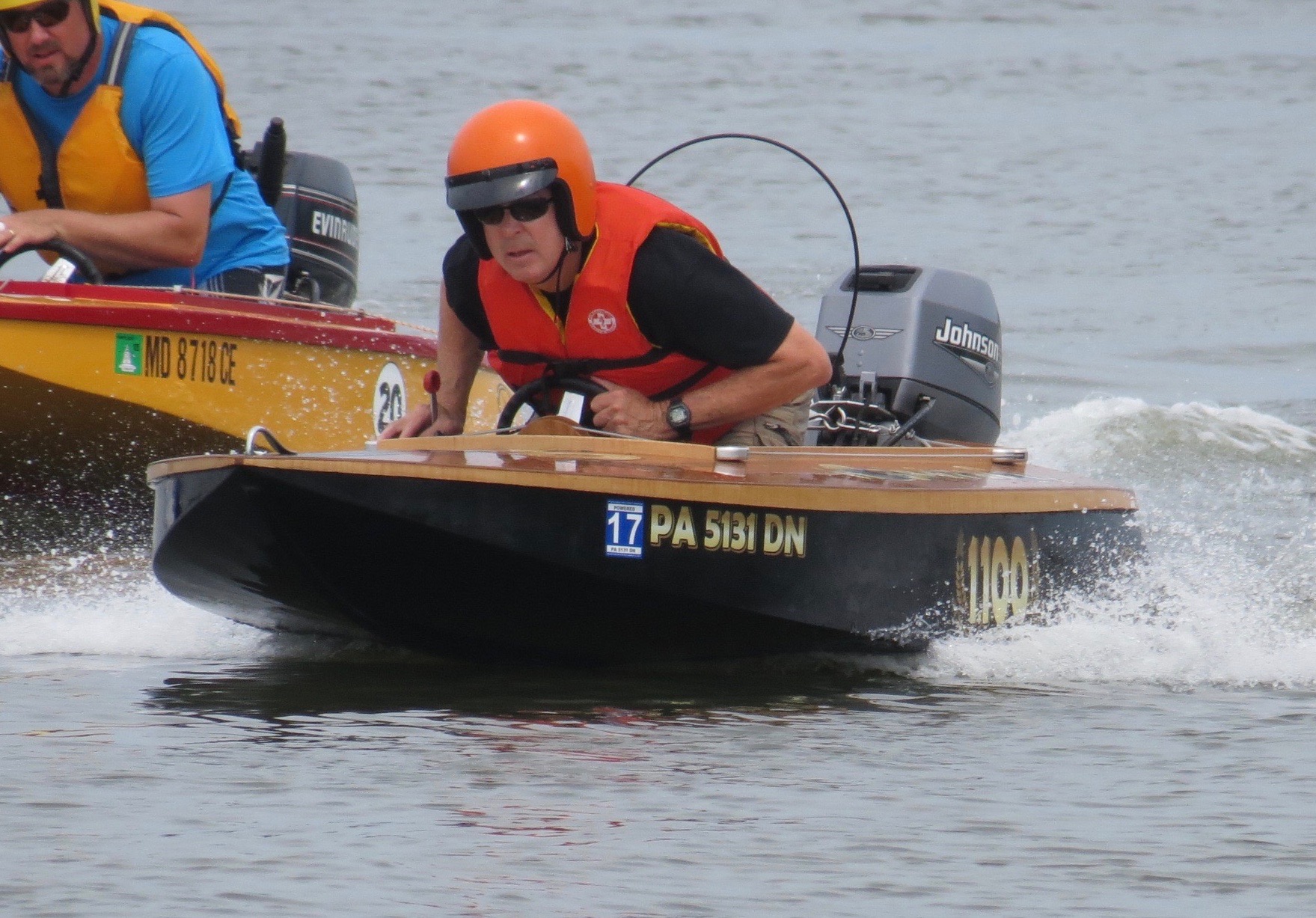Home › Forums › Wooden Boat Building › Marty & Jack's build from CLC kit
- This topic has 36 replies, 5 voices, and was last updated 3 years, 7 months ago by
Marty Calon.
-
AuthorPosts
-
September 13, 2018 at 7:52 pm #10542
Marty Calon
ParticipantDeck installation continues: As you can see from the picture above, the deck on the left side cockpit had to be trimmed straight rather than flush to the cockpit side at the forward 18 inches or so. We used the handsaw and then the flush-cutting router bit on the rest of it.
I gauged where the cut had to go by measuring and test-fitting the front coaming piece–it can be aligned with the steering hole in the frame–and seeing where the side coaming had to meet it. I also used a straightedge that is slightly shorter than the cockpit length, and the left coaming piece that will eventually be installed there. After some minor trimming of this piece, I was able to figure out where exactly it had to meet the front piece, and with the handsaw, I cut a straight line to that point. I’ll repeat this process later on the right side.
I got frisky with the handsaw and cut away a bit too much of the deck in one area for a couple inches (no pics at this time, I can post one later). When all is said and done, we think that this “hole” next to the coaming will be mostly covered with the epoxy fillet and possibly two millimeters or so of a filled-in area next to that.
We installed the second (right) deck half separately, as discussed earlier, using a combination of screws and weights to hold it down at the seam with the left deck half. This did not result in a completely flush joint, partly because I used the thicker wood-fiber epoxy mix instead of the thinner cello-fil mix for the adhesive. Later, we will do what we can to disguise this.
If I were building another one, I’d install the deck as described in the kit instructions, in a single piece. I was intimidated by the scope of that job, but now I know what’s involved. Given the heat wave we had recently, which speeds up the rate at which the epoxy hardens–It was 95 degrees in the garage–I think that a one-piece deck install is best left for a cooler day. Our second deck half went in at temperature in the low 60s, which gave us plenty of time to work the epoxy, align everything, etc.
Pictures below show the second deck half and the squeeze-out mess at the seam of the two deck pieces after the screws and pads were removed. I’ve already mostly sanded away the excess epoxy and some of the high-side wood, but I don’t want to remove any more wood.
We used several methods to trim the outside of the left deck half. Jack used a belt sander to remove most of the outside overhang, and I followed that with a sanding block to make it flush and round it. I had a quarter-round router bit and we tried it on a few inches, but we weren’t happy with the result. It’s not a true right angle, so the bit doesn’t align quite right. The hand sanding block with 80-grit rounded it fast enough, since the overhang had already been removed.
-
This reply was modified 6 years, 8 months ago by
Marty Calon.
October 4, 2018 at 5:09 pm #10574Marty Calon
ParticipantThe inside deck edges had some excess sawed off with the pull saw, then were sawed, flush-routered, and sanded to shape. Due to the afore-mentioned misaligned cockpit sides, both the left and right front ends and the right rear end of the coamings (rails) will have to “float” over the cockpit sides and some gaps where I cut away slightly too much deck will be filled with epoxy, as will the gaps under these rails. More about that later.
The screw holes have been filled with epoxy.

There were no surprises, including the consequence of installing it in two steps: a slight (one millimeter?) height difference at the seam. I expected this, and have dealt with it partially by sanding the high side, and then “skim coating” the low side with a thin layer of wood flour epoxy, sanding that down, and covering it with a layer of unthickened epoxy, which will also be lightly sanded before fiberglassing the deck.

After applying the above clear coat to the bow seam, I applied a thin layer of leftover epoxy to the exposed end grain of the deck all the way around the inside and outside.
In between the deck work, we’ve been test-fitting, trimming, and epoxying the coaming rails, so they’ll be ready to install after the deck is fiberglassed.
The next work session will be some light sanding and cleanup, then fiberglass cloth on the deck as described in the instruction manual.
October 5, 2018 at 9:22 am #10579 Jeffrey WeeberParticipant
Jeffrey WeeberParticipantI’m glad to see that those plastic clamps are coming in handy!
October 7, 2018 at 4:36 pm #10584Marty Calon
ParticipantYes, the PVC clamps were great. Thanks again!
Our friend Jim (whom I helped build a CLC Mill Creek kayak some years ago) is going to build a CLC dinghy for a friend of his with a big wooden boat, who would like a classy small wooden boat as his dinghy, instead of an inflatable. I will pass the PVC clamps on to Jim if he needs them for that project.
I haven’t mentioned that we’ve done much sanding of various joints and surfaces with decreasing grits, generally 80 for material removal, then 120 or 150 for smoothing. We do this as we go along with the construction, to keep everything smooth and ready for the next step. Much of this is hand-sanding, often with a sanding block, but we also use a power palm sander for larger areas.
An important point here is to change to fresh sandpaper frequently when sanding epoxy. It’s much easier to spend a few dollars on more sandpaper than to expend a lot of effort trying to sand epoxy with worn sandpaper.
We’ve also put a first coat of epoxy on the three coaming pieces, with special attention to the back (out-facing) sides and all edges. This is easier to apply now than to deal with after installation. As with everything else, these pieces have been lightly sanded after the epoxy set to get them smooth and ready for what’s next.
I’m fairly sure now that we’ll have this boat in the water next season. We hope to finish the epoxying of all the surfaces this season before it gets too cold, and do what we can in the winter with regard to hardware, painting, and graphics. The fiberglass cloth will be installed on the deck this week.
One thing we’ve wondered is if the hole for the kit-supplied threaded steering rod can stand up to the abrasion that will result from the use of the steering wheel. I’m thinking of installing a piece of 1/2-inch PVC conduit or copper pipe, whatever loosely fits the steering rod, to act as a bushing. Any comments on that idea would be appreciated.
October 10, 2018 at 2:56 pm #10595Marty Calon
ParticipantToday we did some final sanding of the rails and the deck, thoroughly wiped off the dust, and applied fiberglass. No surprises, it went smoothly, but we had to take into account that the cloth is barely wide enough to get the edges of it to the bottom of the rails at the boat’s widest point. We used the “pour and spread” method of applying expoxy to the deck, and a 3-inch brush for the rails, as described in the manual.
To fit the cloth, we epoxied the main front part of the deck, then the left side to “hold” the cloth in place, then the right side. We had to maneuver the right side cloth into position and hold it there until it was epoxied (at the widest point), otherwise the sag into the cockpit pulls it back too far. It’s not hard to do, we just had to work with it.
I hope to sand the deck tomorrow if the epoxy has hardened sufficiently. There are areas that need to be leveled and smoothed. Then I’ll apply another coat of epoxy with a roller.
-
This reply was modified 6 years, 7 months ago by
Marty Calon.
October 11, 2018 at 2:17 am #10597Terry K (TK) Walker
ParticipantThanks Marty for the Update ….. TK
October 16, 2018 at 2:58 pm #10620Marty Calon
ParticipantTemperature right now is too low for epoxy. I hope that we have a warm spell before the cold sets in so we can get some more work done this season. In the meantime, this is what we got done through yesterday.
Fiberglass has been trimmed and sanded around all the edges and the deck surface has been sanded lightly all over and wiped off.
The three rail (or coaming) pieces have been previously “primed” with epoxy on all the edges and on the surfaces that will be attached, then lightly sanded and wiped off.
Front cockpit rail was installed. It’s aligned on the steering hub hole, which leaves it projecting above the deck by 3/4 inch, so the side rails were trimmed to the same height on their back ends, where they “hang” on the transom.
An unexpected visitor dropped in:
Right rail was tacked in with thickened epoxy at the front, center (where it touches the cockpit side) and rear at the transom. We used no screws, an ancient bar clamp at the rear, a modified pipe clamp at the center (to push out), and an upside-down corner clamp at the front. The corner clamp was susceptible to getting out of alignment, so we had to watch it carefully and adjust as needed until it was all where it should be.
I have mentioned that we did a bad job of aligning and keeping straight the cockpit sides during the early stages of construction. I also didn’t do a very good job of trimming the deck to where the edges should have been. We’re working around that, and the rails will end up where they should be.
For this rail, we have to fill gaps between the rail and the cockpit side in front and back; the middle of it is flush with the cockpit side and is already attached at that point. The photo below shows the 3/16-inch gap at the back; the deck was cut back flush with the cockpit side. I filled this gap yesterday from above (no picture) with wood fiber epoxy mix, after the epoxy tacks from the day before had set. I used a 4-inch spreader to push the mix into the gap until it emerged at the bottom, where I removed excess and smoothed it with my finger, and checked the straightness of the rail.
I also put a small fillet along the outside of the rest of the rail because the front gap will be filled (later) with liquid epoxy when the boat is turned over to coat the hull; this fillet will seal it (I hope), and the liquid epoxy should flow into any remaining gap behind the rail.
At this point, the rail is as straight as it needs to be for aesthetic purposes. I’d like to get the left rail installed soon if the temperature cooperates. The rear half will attach directly to the cockpit wall as it should, the only gap to be filled will be in the front.
October 16, 2018 at 8:47 pm #10621Terry K (TK) Walker
ParticipantMarty thanks for the update…. By the way what kind of temps are you having in your neighborhood …. TK
October 17, 2018 at 7:53 pm #10622Marty Calon
ParticipantTemps right now are in low 60s to 50s for highs, and 40s to low 50s for lows, a bit cooler than it usually is at this time of year in Central Maryland.
As I understand it, the epoxy should not go below 60 degrees, not sure for how long after it’s mixed and while it sets. The garage is free-standing and uninsulated, so it doesn’t hold much heat when the weather gets cooler. Jack can goose it into the 60s with a space heater when it’s in the 50s outside, but he justifiably doesn’t want to leave it on unattended, with a gallon jug of acetone and two motorcycles in there.
Jim tried a kerosene heater in his garage when we built the kayak, but apparently the residue from its combustion had a negative effect on the epoxy, so he stopped using it.
If anyone has comments about ambient temperature and using epoxy, I’m interested. I was hoping for a few more weeks of warmish weather to finish the rails and put two coats of epoxy on everything, but it doesn’t look good for that right now, unless we get a lovely warm spell.
October 24, 2018 at 4:33 pm #10632Marty Calon
ParticipantWe had a bit more weather that was barely warm enough for epoxy, so gave up Rock Hall Oktoberfest last saturday and stayed in Baltimore to install the left side cockpit rail.
Here’s a shot of the 3/16-inch gap that we filled on the right side, after the epoxy tacks at front, middle, and back had set. We pushed in thickened epoxy from above until it came out the bottom, then cleaned up:
We used a lightly-applied clamp after the gap was filled because the rail bowed out slightly at one point near the back. The end result was straight enough:
The left rail went in, again with upside-down corner clamp at the front, several other clamps, and epoxied wherever it made contact. The alignment didn’t end up quite as well as the right side, but it’s serviceable and certainly better than if we had just followed the cockpit sides.
We ended this phase by putting small fillets on the four inside corners, and along the side rails between deck and rail. These seal the top of the joint to allow for pouring unthickened epoxy into the remaining narrow gaps behind the rails after we turn over the boat to coat the hull. (Picture below is before left fillet was applied.)
Installing these rails involved much more work and multiple epoxy sessions than should have been necessary. Lesson learned: Check and measure the alignment of the cockpit sides carefully and make sure that they stay straight and aligned as the boat is assembled.
With a few minor exceptions, epoxy construction is now finished. When we have more warm weather, we’ll start coating the cockpit, deck, and hull with epoxy. Almost all of that already has a first coat and a light sanding to knock down the nubbins.
November 19, 2018 at 3:16 pm #10642Marty Calon
ParticipantSome end-of-season odds and ends.
Steering wedge epoxied in place:
You might be able to see below that the top edge of the wedge sits proud of the coaming a little bit, because it’s aligned on the hole and the bottom edge. I sanded it flush after the picture was taken:
Steering pulley was assembled as a side job whenever leftover epoxy was available:
Some advice about this piece: It’s a good idea to use the threaded rod, covered in the relevant area with a single layer of masking tape, as a handle and alignment tool for assembling this, as the manual suggests. However, once assembled, with four spring clamps holding it, set it on a flat, level surface and carefully twist out the threaded rod, being sure to not disturb the alignment. If the rod is left in while the epoxy sets, it’s harder to get out, in spite of the masking tape.
I built this piece in two phases, because I was using leftover epoxy from other work. This also made it easier to coat the edges of the inside layers with epoxy, before attaching the second outside piece.
That’s it for the season. The epoxy construction part of the boat is finished, but there’s still much finishing and hardware work left. We’ll get in there one day when the weather is amenable and do a big cleanup of the work area, in preparation for resumption of work in the spring.
April 10, 2019 at 6:13 pm #11011Marty Calon
ParticipantOver the winter, in the house, I epoxied the steering hub and the wood washer. I also used some wood-flour epoxy mix to fill some small damaged areas in the floor of my nearly 100-year old condo. While the repair to the brown pine floor is visible, it looks much better than the deep gouges that were there.
Last week, we applied the second coat of epoxy with foam roller (and brush in the corners and small areas) to the inside of the cockpit, the deck, and the outside rails, except the bottom of the rails. This went gratifyingly quickly, compared to the excruciatingly tedious process of filleting.
I’ll take a few pictures soon, but the boat doesn’t look much different, now that physical construction is finished. We’ll continue with the additional coats of epoxy over the next few weeks, then serious sanding starts, to prep for the paint and varnish. I borrowed an orbital sander, and I have a shop vac to connect to it to reduce the dust.
I think that the deck looks good enough to varnish it and the rails, the rest of the hull will be painted. We’re not sure yet about the interior.
May 28, 2019 at 2:39 pm #11125Marty Calon
ParticipantWe’ve spent the last few weeks applying several coats of epoxy to the cockpit, deck, and hull of the boat. That is mostly finished, although we might put one more thin layer on as there are a few areas where I can still see the weave of the fabric.
Lesson learned: To fill the weave, one has to use a well-saturated foam roller and not spread the epoxy too thin. This is not difficult on surfaces that are level or nearly so, it’s harder on vertical surfaces, where only so much can be applied before it starts to flow down.
I found that after application, I have to spend considerable time with roller, brush, and a rag to smooth out the runs and remove excesses at the edges of the work area.
We’ll finish epoxy on the exterior next weekend, and commence sanding while the boat is upside down, then we’ll finish the deck and cockpit areas.
Next photo shows how I applied unthickened epoxy into the gaps between coaming and cockpit side that I have mentioned previously. Remember that the boat is upside down and I am sitting under it in the cockpit, injecting the epoxy into the underside of the coaming. The side of the coaming, where it meets the deck, has been filleted and thus did not leak epoxy. For this procedure, we had to adjust the boat so the coaming was level. The photo is for demonstration, the job was done previously.
Below are photos of the back of the keel, and the front of the keel and the bow area.
June 11, 2019 at 4:11 pm #11155Marty Calon
ParticipantWe sanded the entire exterior of the boat a few days ago, using 150 and 220 grit by hand, and 220 in the orbital sander. We didn’t want to be too aggressive with the sanding, only using slightly coarser grade 120 in a few spots where excess epoxy has to be knocked down.
In spite of our best efforts, there are areas that are still uneven enough to not be fully sanded–the small shallow spots won’t sand without removing a fair amount of material around them and possibly risking cutting into the fiberglass cloth. I hope that primer adhesion will be sufficient to deal with these areas.
Advice would be appreciated. It’s almost impossible to put down a completely smooth, even, level coat of the stuff, at least at our level of experience.
The exterior will be painted up to the bottom of the rails. When we turn the boat over to work on the deck and interior, we’ll attempt an even smoother finish for the deck, because it and probably the interior will be varnished.
The cockpit will be more labor intensive to sand, and I’m going to do some of it with the boat still upside down, and me sitting under it with the cockpit front, back and sides more or less at face level. Jack disagrees, but for me that will be far easier than reaching in from above.
June 24, 2019 at 11:23 am #11289TX_Spencer
ParticipantI had low spots also, and the primer seemed to do a really good job. I put two coats of primer on.
When I sanded the first coat, it showed most of the low spots, and it filled them in more than I expected. I hand sanded the low spots as best I could to get them rough for adhesion.
I used interlux, that is some good stuff.
-
This reply was modified 6 years, 8 months ago by
-
AuthorPosts
- You must be logged in to reply to this topic.
